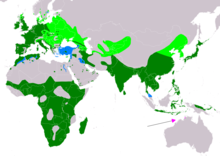The little grebe (Tachybaptus ruficollis), also known as dabchick, is a member of the grebe family of water birds. The genus name is from Ancient Greek takhus "fast" and bapto "to sink under". The specific ruficollis is from Latin rufus "red" and Modern Latin -collis, "-necked", itself derived from Latin collum "neck".[2]
| Little grebe | |
|---|---|
 | |
 | |
| Two adults in breeding plumage, below with feathers pressed against the body, for low buoyancy | |
| Scientific classification | |
| Domain: | Eukaryota |
| Kingdom: | Animalia |
| Phylum: | Chordata |
| Class: | Aves |
| Order: | Podicipediformes |
| Family: | Podicipedidae |
| Genus: | Tachybaptus |
| Species: | T. ruficollis |
| Binomial name | |
| Tachybaptus ruficollis (Pallas, 1764) | |
 | |
| Synonyms | |
|
Podiceps ruficollis | |
At 23 to 29 centimetres (9 to 11+1⁄2 inches) in length it is the smallest European member of its family. It is commonly found in open bodies of water across most of its range.
Taxonomy
The little grebe was described by the German naturalist Peter Simon Pallas in 1764 and given the binomial name Colymbus ruficollis.[3][4][5] The tricolored grebe was formerly considered conspecific, with some taxonomic authorities still considering it so.
Subspecies
Seven subspecies are currently accepted, four widespread, and three with restricted ranges; they are separated principally by size, eye colour, which varies from dark to light from west to east, and extent of white on the secondary feathers of the wing, which varies from none in temperate northern regions, to extensive white in tropical regions.[6][7][8]
| Summer | Winter | Scientific name | Distribution | Notes |
|---|---|---|---|---|
 Brussels, Belgium |  Lac de Tunis, Tunisia | T. r. ruficollis Pallas, 1764 | nominate, Europe to western Asia, south to northern Africa; northeast European birds migratory, others resident. | Eye dark brown; secondaries with no or minimal white. |
 Bharatpur, Rajasthan, India |  Coimbatore, Tamil Nadu, India | T. r. albescens (Blanford, 1877) | Southern and central Asia from Turkmenistan to southern Kazakhstan, south to Sri Lanka, and east through Pakistan, India, Nepal, Bhutan and Bangladesh to Myanmar; central Asian birds migratory, south Asian birds resident. | Eye orange to yellow; bill short; secondaries with extensive white. |
 Al Jahra, Kuwait |  Kuwait | T. r. iraquensis (Ticehurst, 1923) | Tigris–Euphrates river system in southeastern Iraq, southwestern Iran, and Kuwait; resident. | Eye dark brown; bill short; secondaries with extensive white. |
 Marievale, Gauteng, South Africa |  Marievale, Gauteng, South Africa | T. r. capensis (Salvadori, 1884) | Sub-Saharan Africa, Madagascar, Comoros. | Eye reddish brown; secondaries with extensive white. |
 Sakai, Osaka, Japan |  Kihoku, Mie Prefecture, Japan | T. r. poggei (Reichenow, 1902) | Eastern Asia, in China, Korea, Taiwan, Japan, and the south Kuril Islands. | Eye pale yellow to white; bill long; secondaries with no or minimal white. |
| T. r. philippensis (Bonnaterre, 1790) | Northern Philippines (Luzon and nearby islands), Borneo. | Eye pale yellow to white; bill long; secondaries with white. | ||
| T. r. cotabato (Rand, 1948) | Southern Philippines (Mindanao). | Eye pale yellow to white; bill long; secondaries with white. | ||
Description
The little grebe is a small water bird with a pointed bill. The adult is unmistakable in summer, predominantly dark above with its rich, rufous colour neck, cheeks and flanks, and bright yellow gape. The rufous is replaced by a dirty brownish grey in non-breeding and juvenile birds.
Juvenile birds have a yellow bill with a small black tip, and black and white streaks on the cheeks and sides of the neck as seen below. This yellow bill darkens as the juveniles age, eventually turning black in adulthood.
In winter, its size, buff plumage, with a darker back and cap, and “powder puff” rear end enable easy identification of this species. The little grebe's breeding call, given singly or in duet, is a trilled repeated weet-weet-weet or wee-wee-wee which sounds like a horse whinnying.
Distribution
This bird breeds in small colonies in heavily vegetated areas of freshwater lakes across Europe, much of Asia down to New Guinea, and most of Africa. Most birds move to more open or coastal waters in winter, but it is only migratory in those parts of its range where the waters freeze. Outside of breeding season, it moves into more open water, occasionally even appearing on the coast in small bays.[1]
Behaviour
The little grebe is an excellent swimmer and diver and pursues its fish and aquatic invertebrate prey underwater. It uses the vegetation skilfully as a hiding place.
Like all grebes, it nests at the water's edge, since its legs are set very far back and it cannot walk well. Usually four to seven eggs are laid. When the adult bird leaves the nest it usually takes care to cover the eggs with weeds. This makes it less likely to be detected by predators.[9] The young leave the nest and can swim soon after hatching, and chicks are often carried on the backs of the swimming adults.[10] In India, the species breeds during the rainy season.[11]
Gallery
- T. r. ruficollis in Spain; no white in the wing
- T. r. poggei in Japan; no white in the wing
- T. r. albescens in India; extensive white in the wing
- Nest at edge of lake in Jodhpur, Rajasthan, India
- Grebe displaying its webbed feet
- Diving at Delta del Llobregat, Barcelona
- Chick
- Eggs, Collection Museum Wiesbaden
References
External links
Wikiwand in your browser!
Seamless Wikipedia browsing. On steroids.
Every time you click a link to Wikipedia, Wiktionary or Wikiquote in your browser's search results, it will show the modern Wikiwand interface.
Wikiwand extension is a five stars, simple, with minimum permission required to keep your browsing private, safe and transparent.









